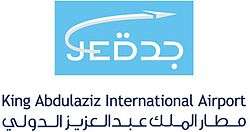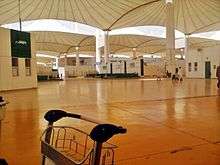King Abdulaziz International Airport
| King Abdulaziz International Airport مطار الملك عبدالعزيز الدولي Mataar Al-Malik Abdulazīz Ad-Dowaliy | |||||||||||||||||||
|---|---|---|---|---|---|---|---|---|---|---|---|---|---|---|---|---|---|---|---|
 | |||||||||||||||||||
|
Hajj Terminal | |||||||||||||||||||
| IATA: JED – ICAO: OEJN | |||||||||||||||||||
| Summary | |||||||||||||||||||
| Airport type | Military/Public | ||||||||||||||||||
| Operator | General Authority of Civil Aviation | ||||||||||||||||||
| Serves | Jeddah, Saudi Arabia | ||||||||||||||||||
| Location | Al Madinah Al Munawwarah Road | ||||||||||||||||||
| Hub for | |||||||||||||||||||
| Elevation AMSL | 15 m / 48 ft | ||||||||||||||||||
| Coordinates | 21°40′46″N 039°09′24″E / 21.67944°N 39.15667°ECoordinates: 21°40′46″N 039°09′24″E / 21.67944°N 39.15667°E | ||||||||||||||||||
| Website | www.jed-airport.com | ||||||||||||||||||
| Map | |||||||||||||||||||
 JED Location of airport in Saudi Arabia | |||||||||||||||||||
| Runways | |||||||||||||||||||
| |||||||||||||||||||
| Statistics (2015) | |||||||||||||||||||
| |||||||||||||||||||
King Abdulaziz International Airport (KAIA) (Arabic: مطار الملك عبدالعزيز الدولي) (IATA: JED, ICAO: OEJN) is an aviation facility located 19 km to the north of Jeddah. Named after King Abdulaziz Al Saud and inaugurated in 1981, the airport is the busiest airport of Saudi Arabia and is third largest airport in the kingdom. The airport is known for its Hajj terminal, which is specially built for Islamic pilgrims going to Mecca annually and can handle 80,000 passengers at the same time.
Description
The airport occupies an area of 15 square kilometers.[3] Beside the airport proper, this includes a royal terminal, facilities of Prince Abdullah Air Base for the Royal Saudi Air Force, and housing for airport staff. Construction work on KAIA airport began in 1974, and was finalized in 1980. Finally, on 31 May 1981, the airport opened for service after being officially inaugurated in April 1981.[3]
Facilities
Hajj Terminal

Because of Jeddah's proximity to Islam's holy city of Mecca, the airport is notable for one feature in particular: The Hajj Terminal. Specially built to handle pilgrims to take part in the rituals associated with the annual Hajj, it offers many facilities and can accommodate 80,000 travelers at the same time.
Designed by the Bangladeshi engineer Fazlur Rahman Khan of the architectural firm Skidmore, Owings & Merrill LLP (SOM), it is known for its tent-like roof structure, engineered by Horst Berger while part of Geiger Berger Associates.[4] Ten modules, each consisting of 21 "tents" of white colored Teflon-coated fiberglass fabric suspended from pylons, are grouped together into two blocks of five modules and separated by a landscaped mall between the blocks. Only customs, baggage handling and similar facilities are located in an air-conditioned building. The vast majority of the complex, called "Terminal Support Area", is a flexible, open area, conceived to function like a village, complete with souk (market) and mosque. Not enclosed by walls, this area is sheltered from the intense sun while allowing for natural ventilation.[5]
The Hajj Terminal received the Aga Khan Award for Architecture in 1983. According to the jury, "the brilliant and imaginative design of the roofing system met the awesome challenge of covering this vast space with incomparable elegance and beauty."[6]
At five million square feet (465,000 m²), the Jeddah airport Hajj Terminal is estimated to be among the world's largest air terminals after Beijing Capital International Airport, Dubai International Airport and Hong Kong International Airport. Many airlines from Muslim and non-Muslim countries have used the Hajj Terminal.
Other terminals
Jeddah-KAIA airport serves as a major hub for Saudia who originally had the exclusive use of the South Terminal. In 2007 however, the privately owned Saudi carriers Flynas and Sama Airlines were also given permission to use it. Due to the closure of Sama Airlines, the terminal was only used by Saudia and Flynas. The terminal is now also used by Garuda Indonesia, Kenya Airways, and Korean Air. The North Terminal at Jeddah airport is used by all other foreign airlines.
Expansion project
The new King Abdulaziz International Airport three-stage development started in September 2006, and is currently scheduled for completion in 2018.[7] The project is designed to increase the airport's yearly capacity from 13 million to 80 million passengers. The expansion includes airfield hard standing and paved areas, lighting, fuel network systems and storm water drainage network.
There will also be a newly constructed support services building, renovation of the existing South and North Terminals and upgrades to the existing runway and airfield systems to accommodate the Airbus A380. The three stages, according to GACA – the General Authority of Civil Aviation of Saudi Arabia, will be marked by staged capacity increase to 30 million, 60M and 80M passengers per year. Based on current traffic increases, the existing South Terminal will need to serve about 21 million passengers per year over the next 20 years to meet growing demand. The project has reached the final stages of planning and design, and King Abdullah, the Custodian of the Two Holy Mosques has approved a budget of SR4 billion to build the futuristic new airport to international standards. Abdullah Al-Rehaimy, president of the General Authority of Civil Aviation, has said that the project will be built by local companies.
Southward, Prince Majed Street will connect to the Al-Laith Highway, forming a fast north-south transit route. As well as much improved road access, plans have been made for a high-speed rail link serving the airport. Starting at Prince Majed Street, the link will run into the airport and hook up with terminals[8]
Airlines and destinations
Passenger
Notes
^1 These flights may include a stop between Jeddah and the listed destination. However, the airlines do not have rights to transport passengers solely between Jeddah and the intermediate stop.
^2 Citilink's charter flights to Jakarta are served via Medan and Mumbai.
Cargo
Other facilities
The General Authority of Civil Aviation has the GACA Hangar (Building 364) at the airport.[21]
Accidents and incidents
- On 25 September 1959, a Saudia reg HZ-AAF Douglas DC-4/C-54A-5-DO, crashed shortly after take-off from Jeddah. The cause of the accident was pilot error followed by a stall. All 67 passengers and 5 crew survived.[22]
- On 11 July 1991, Nigeria Airways Flight 2120, a Douglas DC-8-61, suffered cabin pressure problems followed by a fire due to a failed landing gear. The pilots tried to return to the airport but failed to reach the airport as the plane crashed killing all 247 passengers and 14 crew.[23]
- On 1 March 2004, PIA Flight 2002, an Airbus A300B4-200, burst 2 tires whilst taking off from King Abdulaziz International Airport. Fragments of the tire were ingested by the engines, this caused the engines to catch fire and an aborted takeoff was performed. Due to substantial damage to the engine and the left wing, the aircraft was written off. All 261 passengers and 12 crew survived.[24]
See also
![]() Media related to King Abdulaziz International Airport at Wikimedia Commons
Media related to King Abdulaziz International Airport at Wikimedia Commons
References
![]() This article incorporates public domain material from the Air Force Historical Research Agency website http://www.afhra.af.mil/.
This article incorporates public domain material from the Air Force Historical Research Agency website http://www.afhra.af.mil/.
- ↑ "pagenotfound" (PDF). gaca.gov.sa.
- 1 2 "King Abdulaziz International airport – Economic and social impact". Ecquants. Retrieved 7 September 2013.
- 1 2 About KAIA on the GACA website
- ↑ "SOM's Hajj Terminal Wins AIA 25-Year Award". fabricARCHITECTURE. Retrieved 2014-10-01.
- ↑ Aga Khan Awards, Project brief.
- ↑ Aga Khan Award for Architecture.
- ↑ "King Abdulaziz International Airport Development Project". Retrieved 1 June 2015.
- ↑ "The Master Plan". jed. Retrieved 17 September 2011.
- ↑ https://en.aegeanair.com/plan/low-fare-calendar/
- ↑ "Yémen : fermeture de l'aéroport d'Aden pour des raisons de sécurité (source aéropotuaire)" (in French). L'Orient Le Jour. 25 March 2015. Retrieved 25 March 2015.
- ↑ "Korean Air ends Saudi Arabia service in Feb 2017". routesonline. Retrieved 23 November 2016.
- ↑ http://www.routesonline.com/news/38/airlineroute/270034/nesma-airlines-expands-hail-service-in-nov-2016/
- ↑ Faisalabad,
- ↑ "Saudia adds regular Ankara service from Nov 2016". routesonline. Retrieved 22 August 2016.
- ↑ Ghattas, Abir. "Yemen's No Fly Zone: Thousands of Yemenis are Stranded Abroad". Retrieved 8 April 2015.
- ↑ http://www.bworldonline.com/content.php?section=Corporate&title=saudia-to-launch-davao-flights-for-hajj-pilgrims&id=133128
- ↑ "SaudiGulf Airlines to launch on October 29". ch-aviation. 28 October 2016. Retrieved 28 October 2016.
- ↑ ET cargo schedule. Ethiopianairlines.com.
- ↑ "Saudia Cargo Resumes New York Service from Sep 2015". Airlineroute.net. 23 September 2015. Retrieved 23 September 2015.
- ↑ Turkish Airlines Cargo Winter Schedule Archived 4 June 2013 at the Wayback Machine.
- ↑ "Sectors – Safety & Economic Regulations > Contact Information." General Authority of Civil Aviation. Retrieved on 25 February 2012. "1- GACA HANGAR BLDG.364, KAIA, JEDDAH" – Arabic: "1- مبنى رقم 364 – مطار الملك عبد العزيز الدولي -جدة"
- ↑ "Saudi Arabian Airlines DC-5 accident". Aviation-safety.net. Retrieved 16 March 2010.
- ↑ "Nationair Flight 2120 accident". Aviation-safety.net. Retrieved 16 March 2010.
- ↑ "PIA Flight 2002 accident". Aviation-safety.net. Retrieved 16 March 2010.
External links
- King Abdulaziz International Airport new website
- Arrivals and Departures
- Information on the GACA website for the King Abdulaziz Int. Airport Development Project (KADP)
- Airport information for OEJN at World Aero Data. Data current as of October 2006.Source: DAFIF.
- Airport information for OEJN at Great Circle Mapper. Source: DAFIF (effective October 2006).
- Current weather for OEJN at NOAA/NWS
- Accident history for JED at Aviation Safety Network